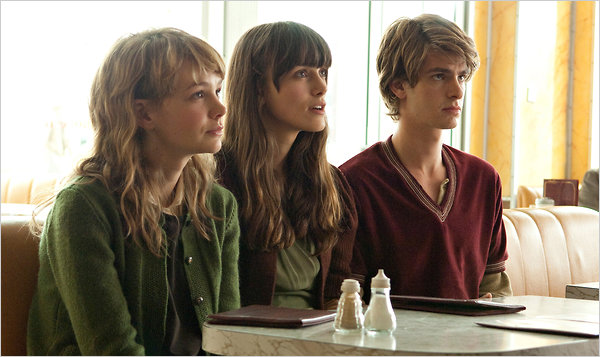Movie review by Greg Carlson
A somewhat less successful cinematic translation of Kazuo Ishiguro than “The Remains of the Day,” director Mark Romanek’s “Never Let Me Go” duplicates some of the stateliness, formality, and quietude of James Ivory’s 1993 film. While the two Ishiguro stories share tonal similarities, the content of “Never Let Me Go” departs significantly from the author’s Booker Prize-winning novel. Blending a somber bildungsroman that relentlessly dissects innocence lost with an allegorical science-fiction premise questioning the morality of genetic cloning, “Never Let Me Go” presents significant challenges to effective adaptation. Screenwriter Alex Garland, who completed a draft of the script prior to the book’s 2005 publication, efficiently streamlines and condenses, even if the intimate interiority granting readers access to the narrator’s thoughts cannot be fully reconciled.
Following an action-framing prologue, the events described by Kathy H. (Carey Mulligan) return to childhood reminiscences of pastoral boarding school Hailsham, a noble and dignified compound populated by future “donors” and their adult “guardians” as part of a social experiment that seeks to raise the clones in a humane approximation of normalcy. As they move on from their eerie alma mater, a love triangle involving Kathy and her two closest friends, Ruth (Keira Knightley) and Tommy (Andrew Garfield), complicates the confusing transition to a cruelly abbreviated period of maturity.
A certain measure of the movie’s strength may be derived from the whispery manner in which Romanek alludes to the horrifying inevitability of “completion” – the post-organ harvest euphemism for death – awaiting the protagonists. Building steadily to a blunt explanation that provides arguably more clarity to the viewer than to the characters, the movie’s first section finds an exasperated teacher (Sally Hawkins, fine as ever) breaking protocol to tell the awful truth to the doomed little ones in her care. Ishiguro’s purposeful refusal to hint at even the tiniest possibility of rebellion on the part of the unfortunate vessels, particularly as they enter adulthood, echoes with tremendous sadness, and the scene in which the grown-up Kathy and Tommy confront their former caretakers with a desperate plea for a deferment is one of the year’s finest, a shattering epiphany expressed with beauty by Mulligan and Garfield.
While all three of the principal performers deliver memorable turns, Knightley’s role has been sharply pruned from the Ruth of the book, whose intimate childhood relationship with Kathy is a complex web of jealousy, confidence, closeness, and rivalry. As a result, the movie struggles to convey the weight of Ruth’s guilt as she tries to right a perceived transgression against her best friend. Because Kathy’s watchfulness diverges from Ruth’s more dominant and outgoing personality, the latter character’s diminished presence in the film quickly becomes Romanek’s largest liability, and the imbalance disrupts some of the urgency of the trio’s interconnectedness as they hurtle toward their fates.
Despite its shortcomings, “Never Let Me Go” invites viewers to consider a number of the same questions posed in Ridley Scott’s dystopian masterpiece “Blade Runner.” What does it mean to be human? How differently do we live our lives if we know the end is coming sooner rather than later? Is it justifiable to treat something identified as non-human with less consideration even if “it” can express joy, pain, and love? Both films invite readings that encompass social and political concerns, and despite their contrasting styles, they remind the viewer that what we choose to do with the time we have is a dear commodity.
